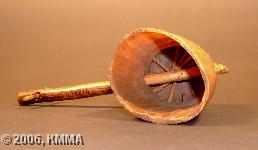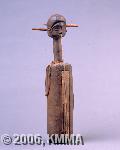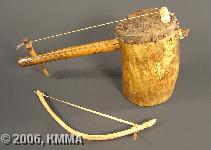


The fiddle is a string instrument, where the string is played with a small bow, rather like the violin. The neck of the instrument is a straight, rigid wooden beam that runs through the instrument. The soundboard cannot therefore be removed without first removing the strings from the instrument. The fiddles in the KMMA collection come partly from the Eastern and South-Western Congo and partly from North and West Africa. With regard to form and structure they are linked to the types of fiddle known in Arabic music culture. The number of strings is limited to two, but the single-stringed fiddles are the most common.
The fiddle always comprises a soundboard, a fingerboard, one or two strings and a bow. The soundboard is a hollow or hollowed out form with a fingerboard running through it. The string runs from one end of the fingerboard to the other, across the soundboard where it is often supported by a small bridge. On top of the fingerboard, close to the end, a hole is made for the tuning peg that is vertically clamped.
The string is attached to this peg and is rolled around the peg; by twisting the peg the instrument is tuned. The string itself is generally made from vegetable material. Finally there is the arch-shaped bow which is made of a thin bent twig to which is attached a cord made of vegetable fibre or horse-tail hair.
Fiddles can be divided into two main types, depending on their construction:
1) The first type is the most common variety, where the fingerboard is a single straight bar to whose extremities the string is attached. Thus the fingerboard runs all the way through the pierced soundboard.
2) The second variation, the most atypical fiddle type, comes from the Kwango region and is played by the Holo people. It is a fiddle that bears a striking resemblance to the anthropomorphous hand slit-drum of theYaka. A small rectangular piece of very light wood is placed over the part where the slit is made, entirely covering the instrument’s hollow interior. A bridge is set on this small piece of wood, and over it run two strings from the mouth of the sculpted head and these are attached behind the skull with two tuning pegs.
To enable the bow to gain more grip when drawn across the string of the instrument, the cord/hair of the bow can be rubbed with a piece of resin. This is often attached to the side of the soundboard so that during play the musician easily rub the hairs of the bow over the resin.
To play the fiddle, the soundboard is held against the abdomen and the neck of the instrument is held in the palm of the left hand, away from the body. The string can be stopped with each middle joint of the index, middle and/or ring finger, so that several tones can be played. With the right hand the player draws the bow, which is held with the tips of the fingers. The fiddles of the anthropomorphic type are sometimes played in another way, e.g. the underside of the instrument can be placed on the ground.
The fiddle player is simultaneously also the singer and generally plays solo. It is hardly ever played by older men or women. The musician has his own repertoire, but it may still be based on, or contain excerpts from the music of other players. The lyrics deal with the villager’s daily life and sometimes also political events.
An important characteristic of fiddle music is the unison of instrument and song, whereby the music is rhythmically influenced by the spoken language that uses long and short syllables.
This type of instrument is used in recordings of our sound archives made with the Congolese peoples mentioned hereafter where it appears with the following vernacular names:
Akaghovoghovo (Nande), Dongu (Ndo), Lungoyongoyo (Kongo), Ndingiti (Hema, Koga), Nkenkete (Mboma / Ndibu)
Bibliography:
Discography:
See also Rwanda
© KMMA